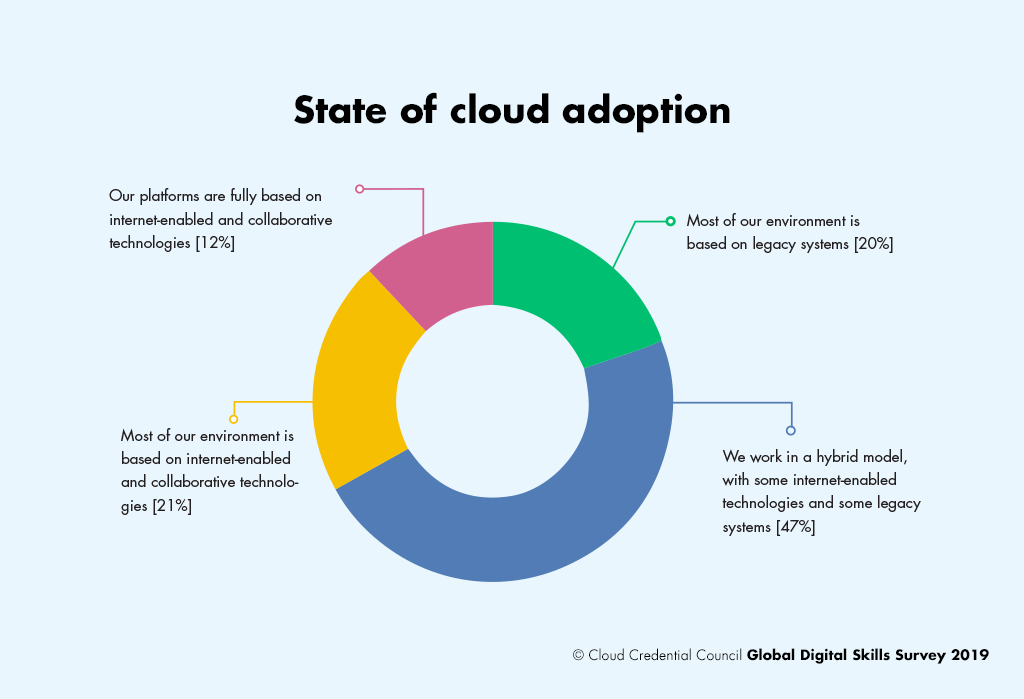State of Cloud Adoption

Mark O'Loughlin

Our Global Digital Skills Survey 2019 report identifies three critical and eight key findings. The analysis covers cultural, individual, and organizational readiness for the changes which are being brought about through the impact of digital.
In this blog, I am focusing on the following critical finding:
State of Cloud Adoption
It is safe to say that the adoption and use of cloud services is increasing year on year. This trend will continue for the foreseeable future.
Many organizations are now using a mix of legacy IT, traditional IT, cloud and digital technologies. Some organizations have little in the way of legacy IT, considered to be digital natives. However, due to the current rate of change in IT and digital IT applications and services what is non-legacy today could quickly become legacy or obsolete in a short period of time. This certainly is one area to watch carefully.
It is no surprise that almost half (47%) of all organizations reported using a hybrid or multi-cloud model where some, or all, of these old and new technologies, are in use. Hybrid and multi-cloud models and strategies are becoming more popular and a standard approach for organizations to adopt. However, to be effective with a hybrid or multi-cloud model and strategy requires more than just focusing on the technology and getting that right. Expect challenges with architecture and security design, interoperability of services from multiple cloud vendors and a raft of subscription and billing options.
Equally challenging will be how IT Service Managers (ITSM) and the IT function provide business services constructed from multi-cloud and hybrid configurations as one seamless business user experience. Providing such services under a default or generic corporate-wide service level agreement (SLA) could prove difficult as the cloud vendors will determine the levels of service they want to provide to consumers, including consuming organizations. Also, vendors are likely to set different levels of service; as they see fit.

Feedback received by the CCC suggests that many IT leaders had expected to see a decrease in the complexity of their IT environments by migrating to cloud and digital technologies.
However, various reports, separate to this survey, also find that; as organizations increase their level and use of the hybrid model, they also experience an increase in the complexity of their IT environments.
The results show 20% of organizations with environments mostly based on legacy systems. These organizations should consider analyzing their situation and reliance on legacy environments. To help the reader, we suggest some basic questions to start with which are available in the full report CCC Global Digital Skills Survey 2019.
The global trend continues. Organizations around the globe continue to adopt more and more cloud and digital IT services. In a recent report, Gartner forecasts worldwide public cloud revenue to grow by 17.5% in 2019.
As expected, most organizations, ready or not, are adopting cloud and various aspects of other digital technologies. This is a current global trend. However, our research indicates that organizations are defining strategies for the adoption of cloud and digital technologies.
What is less clear is how effective these strategies will be in delivering expected, and required business results.
To find out more information and to access helpful advice and guidance, download the CCC Global Digital Skills Survey 2019.

The CCC Global Digital Skills Survey 2019 Report
The report identifies three critical and eight key findings. The analysis covers cultural, individual, and organizational readiness for the changes which are being brought about through the impact of digital.

About the Author
Mark O'Loughlin is the Managing Director of the CCC. Mark is internationally recognized as a global thought leader and published author in digital IT, cloud computing, DevOps, cloud service management, and IT Service Management.
Never miss an interesting article
Get our latest news, tutorials, guides, tips & deals delivered to your inbox.
Keep learning



